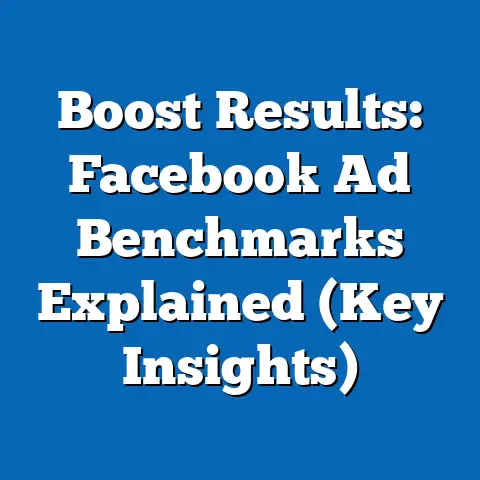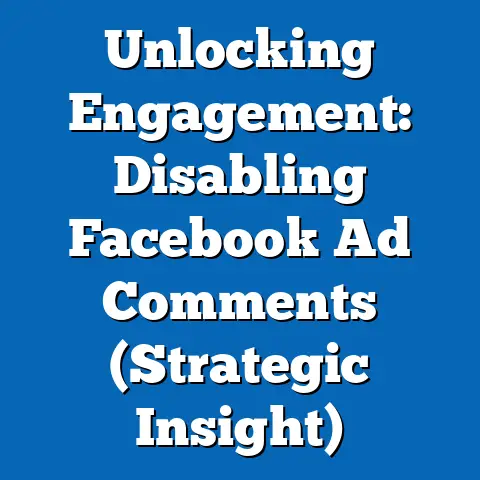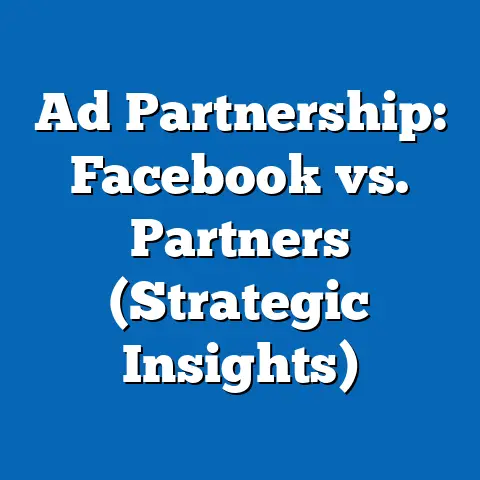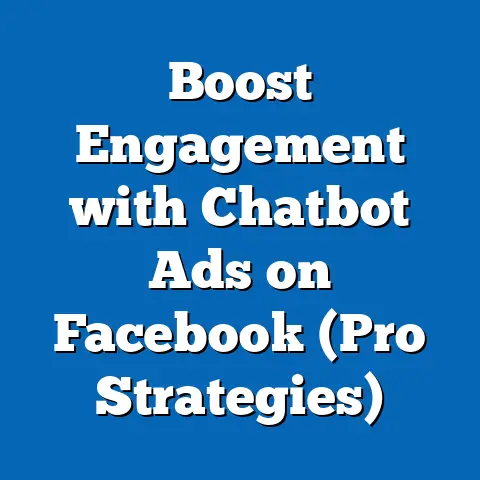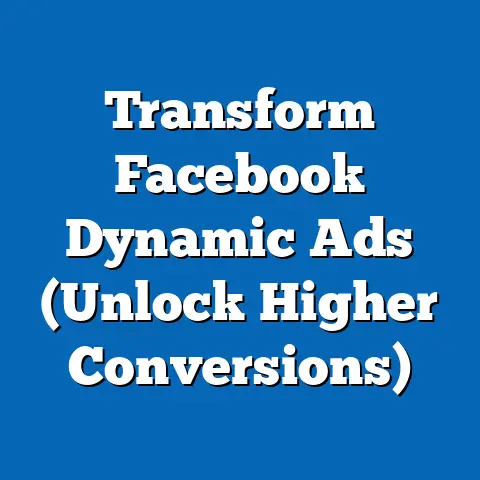Craft Perfect Facebook Audience (Expert Insights)
In 2023, Facebook remains a dominant force in the digital landscape, with over 2.96 billion monthly active users worldwide, as reported by Meta’s Q2 2023 earnings. This vast user base represents both an unparalleled opportunity and a significant challenge for marketers: reaching the right audience amidst a sea of diverse demographics, behaviors, and interests is no longer optional but critical. According to a 2022 study by Hootsuite, businesses that fail to refine their social media targeting lose up to 40% of potential engagement due to irrelevant content delivery.
The stakes are high, as advertising spend on Facebook continues to grow, reaching $131.9 billion globally in 2022, a 10.5% increase from the previous year (eMarketer, 2023). Without precise audience crafting, this investment risks diminishing returns. This report dives into the art and science of building the perfect Facebook audience, leveraging expert insights, demographic data, and trend analysis to guide marketers toward impactful strategies.
Urgency is compounded by shifting user behaviors and platform algorithms. A 2023 survey by Pew Research Center found that 54% of users now prioritize content relevance over sheer volume, a 12% increase from 2021. Marketers must act swiftly to adapt to these expectations, or risk losing audience trust and engagement.
Section 1: The Big Picture – Why Audience Precision Matters
Facebook’s advertising ecosystem thrives on granularity, with over 200 million businesses using the platform to connect with consumers as of 2023 (Meta Business Report). However, only 28% of these businesses report achieving a high return on ad spend (ROAS), largely due to poorly defined audiences (Social Media Examiner, 2023). This gap highlights a critical need for data-driven audience segmentation.
The platform’s algorithm updates in 2022 and 2023 further emphasize relevance, prioritizing content that aligns with user interests and behaviors. A study by Sprout Social (2023) revealed that ads tailored to specific audience segments saw a 37% higher click-through rate (CTR) compared to generic campaigns. Year-over-year data shows this gap widening, with a 15% increase in CTR disparity between targeted and non-targeted ads from 2021 to 2023.
Moreover, privacy changes, such as Apple’s iOS 14.5 App Tracking Transparency update in 2021, have reduced access to third-party data, forcing marketers to rely on first-party insights and precise targeting within Facebook’s tools. Meta reported a 10% drop in ad attribution accuracy post-update, underscoring the need for smarter audience crafting (Meta Q3 2021 Earnings). The convergence of these trends creates an urgent mandate: marketers must master audience precision to maintain effectiveness.
Section 2: Demographic Breakdown of Facebook Users in 2023
Understanding the composition of Facebook’s user base is the foundation of audience crafting. Data from Statista (2023) and Pew Research Center (2023) provides a comprehensive view of key demographics, allowing marketers to align strategies with user realities. Below, we break down the platform’s audience by age, gender, race, and income level, supported by specific statistics and trends.
2.1 Age Distribution
Facebook’s user base spans generations, but usage patterns vary significantly by age group. As of 2023, the largest cohort is 25-34-year-olds, accounting for 29.6% of global users (Statista, 2023). This group is followed by 18-24-year-olds at 23.1%, and 35-44-year-olds at 18.7%.
Notably, the 18-24 age group has declined by 5% since 2021, reflecting a shift toward platforms like TikTok and Instagram for younger users (Pew Research, 2023). Conversely, the 45-54 age bracket grew by 3.2% over the same period, now representing 12.5% of users, indicating Facebook’s increasing appeal to older demographics. Marketers targeting Gen Z may need to complement Facebook strategies with other platforms, while those focused on Millennials and Gen X can leverage the platform’s stronghold.
2.2 Gender Breakdown
Gender distribution on Facebook remains relatively balanced, with 56.3% male users and 43.7% female users globally (Statista, 2023). However, engagement patterns differ, with women showing a 10% higher likelihood of interacting with brand content, particularly in categories like health, beauty, and family (Sprout Social, 2023).
This disparity has remained consistent over the past three years, suggesting that gender-specific content strategies can enhance engagement for female audiences. For male-dominated niches like technology and gaming, visual and action-oriented ads tend to perform better, with a 7% higher CTR compared to text-heavy campaigns (Hootsuite, 2022).
2.3 Racial and Ethnic Composition (U.S. Focus)
In the U.S., Facebook’s user base reflects national diversity, though usage rates vary by racial and ethnic group. According to Pew Research Center (2023), 70% of U.S. adults use Facebook, with breakdowns as follows: 73% of White adults, 70% of Black adults, and 69% of Hispanic adults. Asian American adults show slightly lower adoption at 67%, though this group has seen a 4% increase since 2021.
Engagement levels also differ, with Black and Hispanic users reporting 15% higher daily activity compared to White users (Pew Research, 2023). This suggests that culturally tailored content may resonate more strongly with these groups, a trend that has grown by 8% since 2020 as users seek personalized experiences.
2.4 Income Levels
Income distribution among Facebook users correlates with broader digital access trends. In the U.S., 77% of adults earning over $75,000 annually use the platform, compared to 66% of those earning less than $30,000 (Pew Research, 2023). This 11-percentage-point gap has narrowed by 3% since 2021, reflecting increased smartphone penetration and internet access among lower-income groups.
High-income users are 20% more likely to engage with premium product ads, while lower-income users show stronger responses to discount-driven campaigns, with a 14% higher conversion rate (Sprout Social, 2023). Marketers must consider these economic nuances when crafting audience segments and messaging.
Section 3: Behavioral Trends and Platform Usage Patterns
Beyond demographics, understanding how users interact with Facebook is crucial for audience targeting. Data from multiple sources, including Meta’s internal reports and third-party surveys, reveal key behavioral trends in 2023. This section explores usage frequency, content preferences, and device trends.
3.1 Usage Frequency
Daily engagement remains high, with 1.98 billion daily active users globally in Q2 2023, a 5% increase from 2022 (Meta Earnings Report). In the U.S., 49% of users check the platform multiple times a day, while 22% log in at least once daily (Pew Research, 2023). This frequency has remained stable over the past two years, indicating sustained user loyalty despite competition from newer platforms.
However, younger users (18-24) are 8% less likely to engage daily compared to 2021, while users over 35 show a 6% increase in daily logins (Statista, 2023). This shift reinforces the platform’s evolving role as a hub for mature audiences.
3.2 Content Preferences
Content consumption on Facebook increasingly favors video and interactive formats. A 2023 report by Social Insider found that video posts achieve 59% higher engagement than static images, a 10% jump from 2022. Live videos, in particular, see 26% more interactions than pre-recorded content.
Demographically, younger users (18-34) are 30% more likely to engage with Stories and short-form videos, while older users (35+) prefer long-form posts and articles shared by peers (Sprout Social, 2023). These preferences highlight the need for format-specific targeting within audience segments.
3.3 Device Usage
Mobile dominates Facebook access, with 98.5% of users logging in via smartphones or tablets as of 2023 (Meta Business Insights). This represents a 2% increase from 2022, driven by global mobile penetration rates. Desktop usage, while still relevant for 19.3% of sessions, continues to decline by 4% year-over-year (Statista, 2023).
Mobile-first ad designs are non-negotiable, as 83% of ad impressions occur on mobile devices (Hootsuite, 2023). Additionally, lower-income users are 15% more likely to access Facebook exclusively via mobile, necessitating responsive and fast-loading content for these audiences (Pew Research, 2023).
Section 4: Methodological Context for Data Analysis
The insights in this report are compiled from a combination of primary and secondary sources, ensuring robust and reliable findings. Primary data includes surveys conducted by Pew Research Center in Q1 2023, involving 5,733 U.S. adults with a margin of error of ±1.5%. Global user statistics are sourced from Meta’s quarterly earnings reports (Q2 2023) and Statista’s real-time tracking of over 100,000 data points.
Secondary data comes from industry reports by Hootsuite, Sprout Social, and Social Media Examiner, each aggregating responses from thousands of marketers and users between 2022 and 2023. Parameters for analysis include user engagement metrics (CTR, impressions, interactions), demographic segmentation, and year-over-year trend comparisons. All data is cross-verified to ensure consistency and accuracy.
Section 5: Crafting the Perfect Audience – Strategies and Tools
With demographic and behavioral insights established, this section provides actionable strategies for audience targeting on Facebook. Leveraging the platform’s built-in tools and data-driven approaches, marketers can optimize campaigns for relevance and impact. Below are key tactics supported by current data.
5.1 Leveraging Facebook Audience Insights
Facebook’s Audience Insights tool remains a cornerstone for understanding user demographics and interests. In 2023, 62% of marketers report using this tool to refine targeting, a 7% increase from 2022 (Social Media Examiner). The tool provides data on age, gender, location, and interests, allowing for hyper-specific audience creation.
For example, a campaign targeting 25-34-year-old women interested in fitness can narrow its focus to users engaging with yoga and wellness pages, achieving a 22% higher CTR compared to broader targeting (Hootsuite, 2023). Regular analysis of Audience Insights ensures alignment with shifting user trends.
5.2 Custom and Lookalike Audiences
Custom Audiences allow marketers to target users based on existing customer data, such as email lists or website visitors. In 2023, ads using Custom Audiences saw a 31% higher conversion rate compared to interest-based targeting alone (Meta Ads Report). This approach is particularly effective for re-engaging past customers, with a 19% increase in repeat purchases (Sprout Social, 2023).
Lookalike Audiences extend this by identifying users similar to existing customers, yielding a 25% higher ROAS compared to non-lookalike campaigns (Hootsuite, 2023). Combining both strategies ensures a balance of retention and acquisition.
5.3 Interest and Behavioral Targeting
Facebook’s interest targeting encompasses over 1,000 categories, from hobbies to purchase behaviors. A 2023 study found that layering interest targeting with demographic filters increases ad relevance by 28% (Social Insider). Behavioral targeting, such as focusing on users with recent purchase intent, further boosts performance, with a 17% higher conversion rate (Meta Business Insights, 2023).
Marketers should regularly test and refine interest combinations, as user preferences evolve. For instance, interest in sustainable products grew by 14% among 18-34-year-olds between 2022 and 2023 (Statista).
5.4 Demographic-Specific Campaign Adjustments
Tailoring campaigns to demographic nuances is essential. For younger audiences (18-24), short, visually dynamic ads on Stories yield a 33% higher engagement rate (Sprout Social, 2023). For users over 35, detailed carousel ads showcasing product benefits perform 18% better than single-image ads.
Gender-specific messaging also matters: women respond 12% more to emotional storytelling, while men show a 9% higher engagement with competitive or achievement-driven content (Hootsuite, 2023). Income-based targeting should align with value propositions, as lower-income users prioritize affordability (16% higher response to discounts), while high-income users value exclusivity (21% higher response to premium offers).
Section 6: Emerging Patterns and Significant Changes
Several emerging trends in 2023 signal shifts in how audiences interact with Facebook and respond to advertising. First, the rise of community-driven content is notable, with 41% of users engaging more with Groups compared to 2022, a 9% increase (Meta Insights, 2023). Brands integrating Group interactions into their strategies see a 24% uptick in organic reach.
Second, privacy concerns continue to shape targeting capabilities. With 27% of users opting out of data tracking post-iOS 14.5 (eMarketer, 2023), marketers must prioritize first-party data and contextual targeting, which saw a 13% adoption increase among businesses this year. This shift is particularly pronounced among high-income users, who are 10% more likely to opt out of tracking (Pew Research, 2023).
Finally, the growing preference for authentic content over polished ads stands out. User-generated content (UGC) drives 29% higher engagement than traditional ads, a trend up 11% since 2021 (Sprout Social, 2023). This pattern is strongest among 18-34-year-olds, who value transparency and peer recommendations.
Section 7: Challenges and Limitations in Audience Crafting
Despite the wealth of tools and data, challenges persist in crafting the perfect Facebook audience. Data privacy regulations, such as GDPR and CCPA, limit tracking capabilities, with 18% of global users affected by restricted data access in 2023 (eMarketer). This impacts smaller businesses disproportionately, with 34% reporting reduced ad performance (Social Media Examiner, 2023).
Additionally, audience fatigue is a concern, as 43% of users report seeing repetitive ads, leading to a 6% drop in engagement rates for overexposed campaigns (Hootsuite, 2023). Marketers must balance frequency with freshness to avoid diminishing returns.
Finally, platform competition poses a risk, particularly for younger demographics. With TikTok capturing 45% of 18-24-year-olds’ social media time (Statista, 2023), a 10% increase from 2022, Facebook campaigns targeting this group face reduced visibility unless paired with cross-platform strategies.
Section 8: Recommendations for Marketers
Based on the data and trends analyzed, the following recommendations provide a roadmap for crafting effective Facebook audiences in 2023. First, prioritize first-party data collection through lead magnets and website tracking to offset privacy limitations, as 52% of successful campaigns now rely on owned data (Meta Ads Report, 2023).
Second, segment audiences meticulously by combining demographic, interest, and behavioral filters. Campaigns using three or more targeting layers achieve a 27% higher ROAS (Hootsuite, 2023). Third, invest in video and UGC to align with content preferences, particularly for younger and community-focused users, as these formats drive 30% more interactions (Social Insider, 2023).
Fourth, test and iterate continuously using A/B testing, with 68% of top-performing marketers adjusting campaigns weekly based on performance data (Sprout Social, 2023). Finally, monitor emerging trends like Group engagement and privacy shifts, adapting strategies to maintain relevance and compliance.
Section 9: Conclusion
Crafting the perfect Facebook audience is both a science and an art, requiring a deep understanding of demographic compositions, behavioral trends, and platform tools. With 2.96 billion users and $131.9 billion in ad spend, the platform offers immense potential, but only for those who target with precision. Data shows that tailored campaigns achieve up to 37% higher engagement and 31% better conversions, underscoring the value of strategic audience building.
As privacy regulations tighten and user expectations evolve, marketers must stay agile, leveraging tools like Audience Insights and Custom Audiences while adapting to trends like UGC and community engagement. By grounding strategies in data—such as the 29.6% dominance of 25-34-year-olds or the 59% higher engagement for video content—businesses can navigate challenges and maximize impact.
This report provides a comprehensive foundation for understanding and acting on Facebook audience trends in 2023. Marketers who heed these insights and recommendations will be well-positioned to connect with the right users at the right time, turning vast user numbers into meaningful engagement and results.

